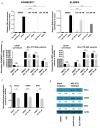Targeting BRD4 in acute myeloid leukemia with partial tandem duplication of the MLL gene
- PMID: 33979989
- PMCID: PMC8409020
- DOI: 10.3324/haematol.2020.271627
Targeting BRD4 in acute myeloid leukemia with partial tandem duplication of the MLL gene
Figures



References
-
- Yue Zhang, Aili Chen, Xiao-Mei Yan, Gang Huang. Disordered epigenetic regulation in MLL-related leukemia. Int J Hematol. 2012;96(4):428-437. - PubMed
Publication types
MeSH terms
Substances
Grants and funding
LinkOut - more resources
Full Text Sources
Other Literature Sources
Medical
Molecular Biology Databases

